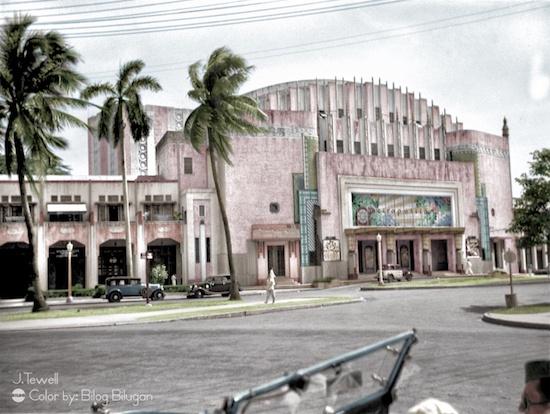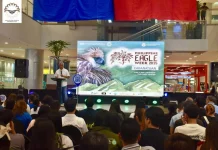The restoration of the Metropolitan Theater (MET) is well underway and its metamorphosis from an old decrepit structure back to being the Grand Old Dame of Manila signals the revival of a Philippine architectural heritage.
The MET was designed by architect Juan Arellano in the Art Deco style and was opened in 1931. Through the years, it hosted performances by local as well as international artists. It was first declared a National Historical Landmark by the then National Historical Institute, presently the National Historical Commission of the Philippines (NHCP), in 1973, and a National Cultural Treasure by the National Museum on June 23, 2010.
The National Commission on Culture and the Arts (NCCA) reports that “Heritage conservation experts have said that the MET is culturally significant, being ‘the only existing art deco building in its scale and integrity in Asia.’”
Its exterior and interior elements exhibit Filipinized style of ornamentation in the melding of ingenious art deco elements and indigenous motifs interspersed by the opulent works of Italian sculptor Franceso Monti and National Artist for visual arts Fernando Amorsolo and other Filipino masters.
The National Commission on Culture and the Arts (NCCA) reports that the historical significance of the MET rests on its connection with historical and cultural figures such as Juan Arellano, Arcadio Arellano, Amorsolo, Antonio Buenaventura and Nicanor Abelardo.
It was accepted as the country’s first “national theatre,” being a venue for cultural performance, social events, and visual art showcases catering to all possible social strata and serving as a proverbial cocoon where the country’s foremost artists launched their careers.
The MET has also figured in significant events related to Philippine political life as a favored social venue by Philippine presidents.
ON WINGS OF SONG
The restoration team of the MET recounts:
“On Wings of Song” was the phrase that inspired Juan Arellano when he designed the Metropolitan Theater. When the building was inaugurated on 10 Dec 1931, with a program that included music, drama, and film, it was hailed as another monumental masterpiece by the gifted architect.
Arellano had designed the Legislative Building and the Post Office Building, both in the neoclassic style. The Metropolitan Theater was stunningly different.
A.V.H. Hartendorp, editor of the Philippine Magazine described it as “modern expressionistic.” It was in fact one of Arellano’s romantic works, and was influenced by art deco, then in its hey-day. While the nearby Legislative and Post Office Buildings were stately and monochromatic, the Metropolitan Theater was festive and colorful.
The site was an 8,393.58-sqm lot in the Mehan Gardens, between Burgos Avenue and Arroceros St, which had been leased by the City of Manila to the Metropolitan Theater Company.
The P1,000,000 needed for the project was raised by public subscription. Arellano was sent to the United States to study with Thomas W. Lamb, an American expert in theater design.
The theater proper was flanked by garden courts around which were two-story buildings housing the ballroom, restaurant, offices, and shops. The front of the theater was crowned by a wall gently curved at the top, against which rise a series of pinnacles.
The entrance resembled a proscenium, on the lower half were doors with iron grills depicting stylized birds of paradise, and on the upper half was a large window of colored glass.
This exterior proscenium was set against undulating walls decorated with brilliantly colored batik patterns.
The two-story lobby, with wide stairways at each end and a balcony overlooking the entrance, was the elegant setting for Fernando Amorsolo’s murals The Dance and History of Music, and the Italian sculptor Francesco Monti’s modern statues.
The original capacity of the auditorium was 1,670 : 846 in the orchestra, 708 in the balcony, and 116 in the loge. Enshrined above the proscenium were figures depicting Music, Tragedy, Comedy, and Poetry, set amid an array of jewel-like plaques.
Adorning the plain walls were lamps, tall tapering tubes of translucent glass in the form of bamboo stalks. On the ceiling was a luxuriant array of rropical fruits and foliage. Hartendorp described the acoustics as”faultless”and the lighting as”excellent.”
The auditorium was destroyed in the last days of WWII, and its subsidiary buildings were used by various establishments. The building was restored under the supervision of Otilio Arellano, a nephew of Juan Arellano, and was reinaugurated on 10 December 1978.
The MET remained intact save for its roofing during the airstrikes at the Battle of Manila in 1945. It was rehabilitated in 1979 through a 30-million pesos loan from the Government Service Insurance System (GSIS) but was closed down in 1996 after a battle of ownership between the GSIS and the Manila local government. I reopened in 2010 but was again closed in 2012. It has since been considered unusable with reported unstable ceilings, moldings on the walls, its electrical wirings and balcony seats missing (stolen), and cracks on the floor.
METAMORPHOSIS
The METamorphosis Facebook page which documents the ongoing developments at the MET recently posted updates on the ongoing painting works on the distinct façade beginning with the technicolor underpainting.
The camouflage pattern of colors will be topped off by off-white topcoat, applied with a roller only on the raised surfaces, creating the batik-like patterns for which the theater is known.
The original paint of the Metropolitan Theater is not in the shades of pink but off-white. The pinnacles and the masks which are painted today in black is originally done in gold.
The ornaments and spires are painted black as well in preparation for their antiqued gold and bronze finishes, as seen in archival photos.
Meanwhile, inside, the narra wood baffles of the theater are being labeled and taken down for repair to be returned later as the METamorphosis team updates the venue’s acoustics for today’s performances.
All these developments are being done under the leadership of the National Commission on Culture and the Arts, the new owners of the MET.
The country’s prime government agency for arts and culture became the new owners of the MET after President Benigno Aquino III had the Department of Budget Management release P270 million from the National Endowment Fund for Culture and the Arts (NEFCA) for the sale of the Met from its owner, the GSIS.
According to the NCCA report the NCCA Board of Commissioners emphasizes that there is a need to revive a great architectural landmark of the artistic and cultural creativity of the Filipino people and to restore it according to the highest standards of heritage conservation: “This will indeed be an iconic building of Filipino heritage that affirms the NCCA’s vision of the Filipino culture as the wellspring of global and national well-being.”
The NCCA initially envisions a restored MET to become a center for arts and culture, with additional exhibition galleries and its theater and performance halls for use by artists and cultural workers as well as by students and the general public. The Commission also expects the MET to provide additional space for its various needs in the implementation of the National Cultural Heritage Act.
All images from the METamorphosis Facebook page














